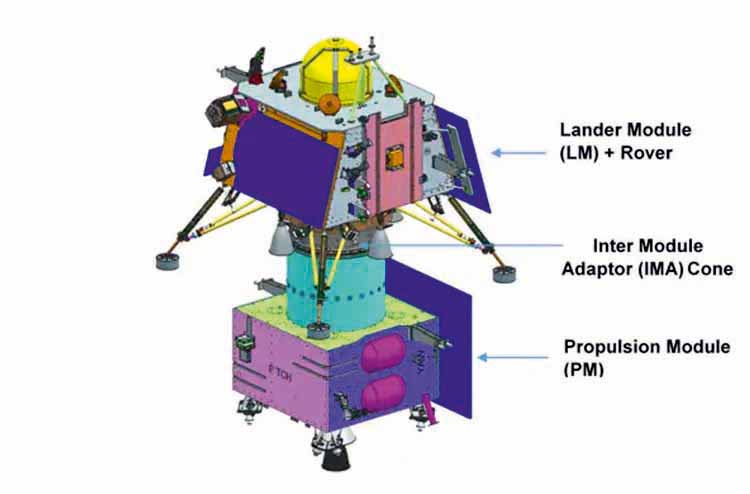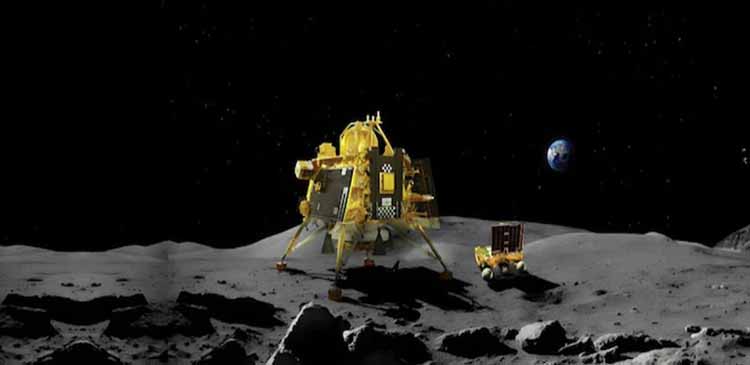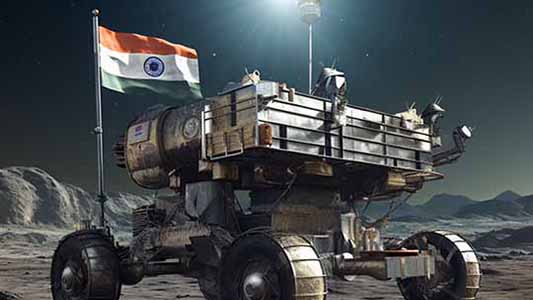India has made history as its Lunar mission becomes the first to land in the lunar south pole region. With this feat, India joins an elite club of countries to achieve a soft landing on the Moon, after the US, the former Soviet Union and China. The Vikram lander from Chandrayaan-3 successfully touched down as planned at 18:04 local time (12:34 GMT).
Chandrayaan-3 was launched on 14 July 2023, at 2:35 pm IST as scheduled, from Satish Dhawan Space Centre in Sriharikota, Andhra Pradesh, India. The spacecraft had been effectively placed in the trajectory it took to reach the moon, covering the distance from the Earth to the moon that is approximately 384,400 kilometres.
The quest for knowledge about our celestial neighbors has driven space agencies across the world to embark on ambitious lunar exploration missions. India, a rising force in space exploration, continues to contribute significantly to this pursuit with its Chandrayaan series. Chandrayaan-3, the third installment in this series, is poised to deepen our understanding of the Moon, particularly its enigmatic south polar region.
Chandrayaan-3’s Components

The Chandrayaan-3 mission comprises three crucial components: the lunar orbiter, Vikram the lander, and Pragyan the rover. The lunar orbiter serves as the command and control center, relaying communication between Earth and the lander-rover duo. Loaded with scientific instruments, the orbiter plays a pivotal role in capturing high-resolution images of the lunar surface and analyzing the moon’s mineral composition.
The Vikram lander, equipped with sophisticated propulsion systems and landing gear, facilitates the rover’s soft landing on the Moon. The Pragyan rover, a technologically advanced exploration vehicle, houses a suite of instruments designed to conduct a range of scientific experiments and observations. These components collectively embody India’s technological prowess and determination to unravel lunar mysteries.
Voyage to the Moon
Chandrayaan-3’s journey begins with a powerful launch vehicle propelling it beyond Earth’s gravitational grasp. Following its launch, the spacecraft embarks on a carefully calculated trajectory, involving precise orbital maneuvers to ensure a successful lunar rendezvous. Upon entering lunar orbit, the spacecraft meticulously adjusts its trajectory to achieve optimal science operations.
Landing in the South Polar Region

Chandrayaan-3’s mission is particularly focused on the Moon’s south polar region—a terrain largely unexplored by previous missions. The region’s permanently shadowed craters, possibly containing water ice and other resources, make it a prime target for investigation. Navigating through these challenges, the spacecraft undertakes a controlled descent, employing cutting-edge guidance and landing technologies to ensure a safe touchdown.
Rover’s 14 Days of Exploration
Once the Pragyan rover is deployed onto the lunar surface, a 14-day window of intensive exploration begins. The rover’s scientific objectives encompass an array of studies, from analyzing the composition of lunar soil to studying the local magnetic field. Instruments onboard the rover, meticulously designed by a team of scientists and engineers, play a crucial role in gathering data that could reshape our understanding of the Moon’s formation and evolution.
Technological Marvels and Achievements
Chandrayaan-3 showcases India’s technological advancements in space exploration. Its landing and mobility systems are a testament to the nation’s engineering prowess. The rover’s self-sufficiency, coupled with its ability to withstand harsh lunar conditions, stands as a significant achievement in itself. Chandrayaan-3’s technological innovations are expected to inspire further space exploration endeavors globally.
Collaboration and Future Endeavors
Chandrayaan-3 is a testament to international collaboration, with space agencies and institutions from various countries contributing to its success. The mission’s data and findings are anticipated to provide a deeper understanding of the Moon’s history and offer insights into the broader field of planetary science. As Chandrayaan-3’s journey unfolds, it also paves the way for future missions, potentially including crewed lunar exploration.
Conclusion
Chandrayaan-3 represents India’s relentless pursuit of knowledge and innovation, propelling humanity’s understanding of our closest celestial neighbor to new heights. With its advanced technology, focus on the south polar region, and collaborative spirit, the mission promises to unravel mysteries that have remained hidden on the Moon’s surface for eons. As the mission progresses, it is poised to make a significant mark in the annals of lunar exploration and inspire generations to come.
Three main components of Chandrayan -3
PROPULSION MODULE:
Chandrayaan-3 Propulsion Module
The propulsion module will carry the lander and rover configuration till 100 km lunar orbit. It is a box-like structure with one large solar panel mounted on one side and a large cylinder on top (the Intermodular Adapter Cone) that acts as a mounting structure for the lander. In addition to the lander, the module carries a payload called Spectro-polarimetry of Habitable Planet Earth (SHAPE) to study the spectral and polarimetric measurements of Earth from the lunar orbit.
THE VIKRAM LANDER:
The Vikram lander is responsible for the soft landing on the Moon. It is also box-shaped, with four landing legs and four landing thrusters of 800 newtons each. It will carry the rover and various scientific instruments to perform in-site analysis.
The Vikram lander for Chandrayaan-3 will have only four throttle-able engines, unlike the lander on Chandrayaan-2 which had five 800 Newtons engines with a fifth one being centrally mounted with a fixed thrust. Additionally, the Chandrayaan-3 lander will be equipped with a Laser Doppler Velocimeter (LDV). The impact legs are made stronger compared to Chandrayaan-2 and increased instrumentation redundancy.
The Vikram lander carries these payloads:
- Chandra’s Surface Thermophysical Experiment (ChaSTE) to measure the thermal conductivity and temperature of the lunar surface.
- Instrument for Lunar Seismic Activity (ILSA) will measure the seismicity around the landing site.
- Radio Anatomy of Moon Bound Hypersensitive ionosphere and Atmosphere (RAMBHA) will probe the gas and plasma environment of the lunar surface.
- LASER Retroreflector Array (LRA)
THE PRAGYAN ROVER:
Six-wheeled designed with a weight of 26 kilograms (57 pounds) and range of 500 metres (1,600 ft), the rover has two payloads – the Alpha Particle X-ray Spectrometer (APXS), and the Laser Induced Breakdown Spectroscope (LIBS). APXS will study the elemental composition of the lunar soil and rocks around the landing site. LIBS will analyse the elements to get a better understanding of the chemical and mineral composition of the lunar surface.
The Pragyan Rover is expected to make a number of important scientific discoveries, including:
– The composition of the lunar surface
– The presence of water ice in the lunar soil
– The history of lunar impacts
– The evolution of the Moon’s atmosphere
The mission is a testament to the country’s growing technological capabilities, and it is sure to make significant contributions to our understanding of the Moon.












